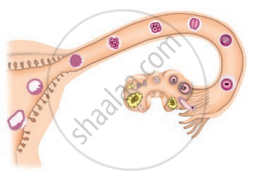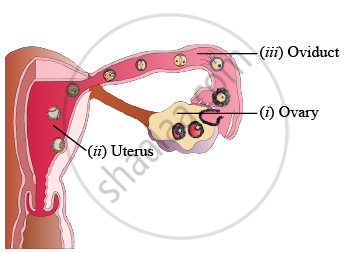Advertisements
Advertisements
प्रश्न

After Observing above figure, answer the following,
- Read the following statements and label them in the figure.
(i) The part which produces female gametes.
(ii) The part where development of the baby takes place.
(iii) The part through which the developing embryo passes to reach the uterus. - Explain the future development of the embryo that would take place after it gets embedded in the uterus.
थोडक्यात उत्तर
उत्तर

- The embryo continues to grow and develop after it gets embedded in the uterus. It divides and differentiates into three germ layers which give rise to different body : parts such as hands, legs, head, eyes, ears, etc. This stage where all the body parts are distinct and easily identified in developing embryo is called foetus.
A human embryo becomes a foetus after about 8 weeks of pregnancy. After completion of development of foetus (i.e. after about 38 weeks or 9 months), mother gives birth to baby.
shaalaa.com
Embryo Formation in Viviparous and Oviparous Animals - Young Ones to Adults
या प्रश्नात किंवा उत्तरात काही त्रुटी आहे का?
APPEARS IN
संबंधित प्रश्न
______ is an oviparous animal.
Match the following.
| 1. | Zycote | Asexual Reproduction |
| 2. | Viviparous | Elephant |
| 3. | Endangered animal | Cat |
| 4. | Mudhumalai | Fertilised Egg |
| 5. | Fragmentation | Rhinoceros |
Differentiate between oviparous and viviparous animals.
Stages in the life cycle of silkworm are given below. Write them in sequential order.
| Pupa | Egg | Silk moth | Caterpillar |
Hens and frogs are both oviparous exhibiting different types of fertilisation. Explain.
